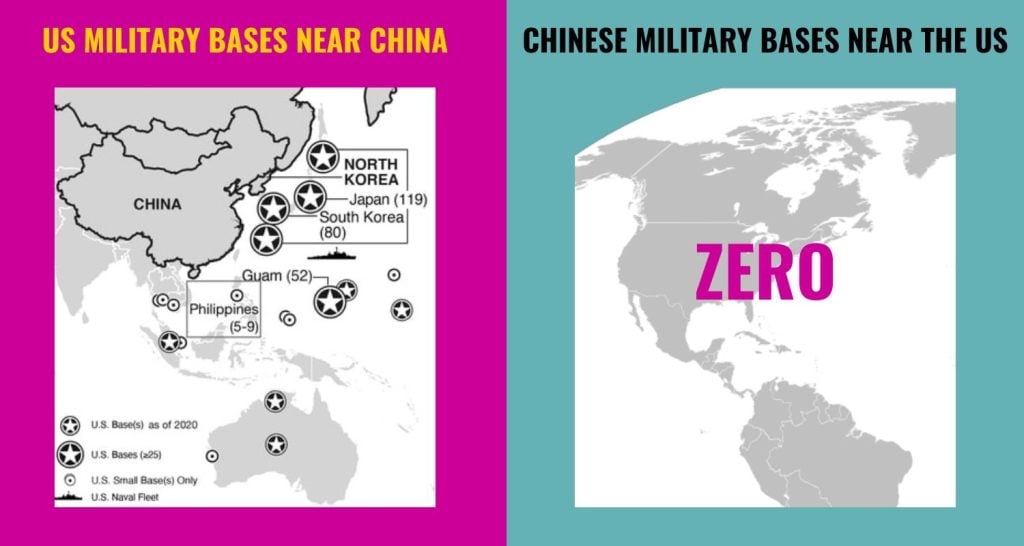Cross-posted from GlobalResearch.ca by Jerry Alatalo | May 6, 2024
*
By Megan Russell
Thousands of innocent civilians are dying– men, women, children– being bombed to death as they sit in their homes.
Thousands of Ukrainian and Russian men have been unwillingly drafted into the military, torn from their families, forced to kill each other, and forced to die.
Images and videos of cold-blooded genocide plague our news in a constant loop, and our government has the audacity to sit in their comfy little chairs and not only deny what is happening, but to also order more money sent to continue these horrors.
The US has a long history of involvement in overseas conflict; this isn’t the first time we’ve had to fight back against militants in power, and it won’t be the last. Now, the US clearly has its sights set on China. Billions of dollars have already been spent militarizing the Asia-Pacific, surrounding China with military bases and conducting threatening war games– the US military’s version of peacocking.
The first step of war, as US military elites are well aware, is information warfare. Currently, the media is spouting hateful rhetoric towards China, contributing to a giant spike in Asian-American hate crime. Our political leaders accuse China of everything the US is guilty of: preparing for war, spying, stifling business. The government is so paranoid they’ve even banned the Chinese social media app Tiktok– an unprecedented divergence from our first amendment rights.
We’re at a critical junction in history. Either we let the US continue to spout narratives of fear and division and drive us towards war, or we sift through the lies, raise the truth, and fight back against the imperialist elite.
It’s time to re-navigate the situation. Let’s step back and debunk some claims.
Statement: China Wants War
Evidence:
China has, throughout its thousands of years of history, long stood for peace and harmony. Modern political ideology is interwoven with ancient Chinese philosophy and the belief that war is a failure of the state.
But let’s look at something nobody can dispute: what are US politicians saying, and how does this compare to what Chinese politicians are saying?
The Chinese Ministry of Foreign Affairs recently published a report detailing five objectives China had for Secretary Blinken’s visit this week, reflecting the ‘Five Principles of Peaceful Coexistence’, a foundational pillar of Chinese foreign policy.
One of those objectives was for “the China-US relationship should be stabilized, improved, and move forward along a path of stability, health, and sustainability.” They also advocated for mutual cooperation, strengthening dialogue, and effectively managing differences.
Meanwhile, numerous US political and military figures have said the opposite, calling for the US to raise arms and surround China with military bases, missiles, and troops. They cite a future war as almost inevitable, declaring that China will “invade” Taiwan by 2027. Just this month, Xi Jinping met with the former president of Taiwan, Ma Ying-jeou, to express their mutual consensus to stand for peace, agreeing that war “would be an unbearable burden for the Chinese nation.”
To summarize, China does not want war. Prominent political figures and spokespersons have repeatedly pronounced their adherence to peace, and have implored the US numerous times to work towards mutually beneficial cooperation rather than current antagonistic practices.
Conclusion: FALSE!
Statement: The US Stands for Peace
Evidence:
You might be thinking: who has ever made that statement? Quite a few, believe it or not.
We’re going to look at the statement in the context of China, and for a moment, leave behind all the other wars the US has been involved in and actively pushed for.
The United States spends more money on defense spending than the ten following countries combined. That’s around $850 billion dollars per year– and every year, the amount goes up. In 2024, the budget request was for $911 billion dollars.
A good amount of this money has been spent building military bases in the Asia-Pacific, surrounding China with threatening long-range missiles and other defense systems. As it stands, the US has over 750 military bases around the world, with 313 bases in East Asia alone. Meanwhile, China has no military bases in the entire Western hemisphere.
US military strategy in the Asia-Pacific operates along one dominant strategy: militarize, militarize, militarize. Policy experts continue to recommend “porcupining” nearby nations, including Japan, the Philippines, and Guam. In doing so, they have repeatedly harmed the natural environment, destroying protected reefs and dumping harmful chemicals into the ocean. Many locals denounce US military presence and rising militarism, terrified they may be pulled into a conflict they want no part in.
The truth is, the US has a long history of war and imperialism. Including militaristic and covert operations, the US has invaded over 50 countries since its inception. Since WW2, the US has started wars in Vietnam, Afghanistan and Iraq, all of which were unmitigated disasters. Adversely, China has not fought a war in 45 years.
The US pushing for a war with China is not new or surprising, but we have to do everything we can to stop the push before it escalates. Tell Biden administration that China is Not Our Enemy and sign the petition telling Congress to vote NO on militarizing the Philippines.
Conclusion: FALSE!
Statement: The US Needs to Protect Itself by Surrounding China with Weapons
Evidence:
Policy experts and military professionals adhere to the concept of deterrence with a disconcerting level of zeal. Logically, and according to their favorite Game Theory 101 class, it makes sense. One is less likely to attack if they are aware how strong their opponent is– aware they would face severe repercussions that outweigh any potential gain.
However, the logic goes sour when you recognize a few basic facts:
- One, China is not an opponent and does not wish to be an opponent.
- Two, hyper-militarizing the Asia-Pacific makes war more likely, not less. It’s not deterrence– it’s provocation.
- Three, the US is trampling on the desires of local populations and harming the environment while at it.
China does not want war, as we’ve covered, and has expressed its concern that US militarization of the region can lead to increased risk for misunderstanding and misjudgment– which could easily escalate into conflict. The US needs to focus on prevention rather than deterrence, by strengthening dialogue, reaffirming commitments to peace, and fostering a partnership with China on other potentially catastrophic issues, such as environmental protection and nuclear disarmament.
Ultimately, there are no gains to be had by throwing billions of tax dollars into militarizing the Asia-Pacific. What the US fails to realize is that there are people living on the land they are abusing. The environment is protected– and sacred– and the military-industrial complex has no place rearing its ugly head where it does not belong.
Conclusion: FALSE!
Statement: The US Needs to “Beat” China to Maintain Power and Position
Evidence:
First, it’s important to acknowledge the origins of such a claim. Why, exactly, does the US need to maintain its hegemonic status over China, and why are our politicians and policy experts so obsessed with the idea?
There are three terrible, powerful factors at play here: colonialism, imperialism, and racism.
Colonialism: The US has a steep history of adhering to colonialist doctrines. Even its inception was a story of colonialism, running Native Americans off their indigenous lands to take over. Over the course of its comparatively short lifetime, the US has seized Puerto Rico, Guam, Samoa, the Philippines, Hawaii, and more. The US government feels it has the right to continue abusing these ties, building military bases against the desire of local indigenous populations.
Imperialism: US imperialism is essentially the belief in the expansion of American political, economic, military, and cultural influences. It ties into colonialism in many ways, reflecting the belief in racial and cultural superiority.
Racism: Racism is one of the driving factors of US imperialism and colonialism– the glamorization of “the white savior” to lead “others” out of barbarity and into salvation. Sinophobia has run rampant in the US for many years, leaking into American politics and media. Since the 2020 global pandemic, Asian American hate crimes have been on the rise.
All three tie together into a twisted undercurrent of thought running below the surface of US foreign policy. While US politicians push us towards confrontation for the sake of preserving a US hegemony, China reports that, “We firmly believe that great power competition should not be the dominant theme of this era, nor can it solve the problems faced by China, the US, and the world.”
Yikes. That’s a stiff departure from Biden’s “we want competition with China” State of the Union speech, and an even worse departure from former Deputy National Security Advisor Matt Pottinger and Congressman Mike Gallagher who say, “The United States shouldn’t manage competition with China; it should win it.” In doing so, they also claim that “the US needs to accept that achieving it will require greater friction in US-China relations.” This is nothing short of an admittance: US political leaders are so concerned with winning some power competition that they’ll risk going to war– push for it, even.
RAND policy experts punched the numbers. Even a minor conflict could lead to a 20-35% economic shrinkage of China’s economy. This would devastate the lives of millions of Chinese citizens. Recovery would take years. It’s no wonder the US imperial agenda is pushing for war.
Conclusion: FALSE!
Imagining a Better World…
The US has spent billions and billions of dollars preparing for war with China. Imagine what the world would look like if those billions had been spent elsewhere– on infrastructure, poverty alleviation, cultivating a peace economy, environmental sustainability initiatives, pushing for love and mutual respect rather than division, fear, and hate…
There is a world where the US and China are capable of a respectful, cooperative relationship, where differences are set aside in accordance with a bigger picture: how can we make the world better for each and every person? How can we cultivate peace? How can we preserve the natural environment and ward off climate change?
Humans have been on this earth for a long time, and yet, we still don’t know what it would be like to live a life of peace. War infects every community, influencing the ways we live and interact with the world. It’s up to us, as citizens of the most militaristic country in the world, to put an end to our government’s rampage of imperialism and fear.
*
Note to readers: Please click the share button above. Follow us on Instagram and Twitter and subscribe to our Telegram Channel. Feel free to repost and share widely Global Research articles.
Megan Russell is CODEPINK’s China is Not Our Enemy Campaign Coordinator. She graduated from the London School of Economics with a Master’s Degree in Conflict Studies. Prior to that, she attended NYU where she studied Conflict, Culture, and International Law. Megan spent one year studying in Shanghai, and over eight years studying Chinese Mandarin. Her research focuses on the intersection between US-China affairs, peacebuilding, and international development.
Featured image is from InfoBrics




